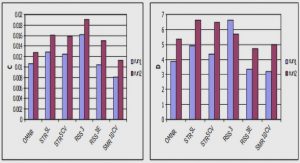Get Complete Project Material File(s) Now! »
Introduction
According to Stats SA between 1996 and 1997 in the non-agricultural sector of the economy, employment opportunities declined by 2,7%. This decline has been consistent over the previous eight years by an average of 1% p.a. A SAIRR survey estimated that in 1996 the unemployment rate stood at 24% of EAP. Stats SA, according to its expanded definition of unemployment calculated the unemployment rate at 29,3% In the report “Poverty and inequality in South Africa”, about 19 million people (about 50% of the population) could be considered poor. These people live below the poverty line of R353 per month. 72% of these people live in rural areas. The poverty gap (the amount needed to raise the poor to the poverty line) was about R28 billion.
76% of this would have to go to rural areas. Furthermore, 60% of children lived in poor households (SAIRR, 1998: 254-257, 409-411). During the previous regime the general population was clearly segmented along racial lines resulting in the state providing essential services of a very high quality to only a small segment of the population. Other sections of the population, particularly the black, coloured and indian were marginalised in terms of the services that they received. By excluding people from full participation in the economy, providing them with third-rate services, by forcing them to settle in squalor conditions and by viciously repressing by means of a massive state machinery, people were constantly on the run and trying to survive and thus could not settle down and create economies of scale.
The repression of communities during the apartheid era was especially bad where communities were repressed by the apartheid regime and a homeland government. Many of the communities visited for the purpose of this study lie on the border of the former Bophuthatswana and it is a well known fact that the homeland’s state University of Pretoria etd – Iturralde, D machinery focused it repressive efforts on the border towns as a way of consolidating the borders of this erstwhile bantustan.
Chapter 1: Background
1.1 Introduction
1.2 The Problem Statement
1.3 Sub Problems
1.4 Research Statements
1.5 Issues to consider with sub problems
1.6 Outline of the Study
Chapter 2: Literature Review
2.1 Introduction
2.2 Fundamentals of Development
2.2.1 Meaning of development
2.2.2 Core values of development
2.2.3 Objectives of development
2.3 Knowledge in development
2.4 Role of the State in development
2.5 Problems with development and how the paradigm shift
influences development
2.5.1 Structural Adjustment
2.5.2 Paradigm shift
2.6 Sociological approach to sustainble development
2.7 African Economic Development
2.8 Study on perceptions of happiness and service delivery
2.9 Poverty and inequality in South Africa
2.10 Anatomy of expectations: A Study of peoples political perceptions
2.11 Further considerations
2.12 Concluding remarks
Chapter 3: Discussion of the Research Methodology used in the study
3.1 Introduction
3.2 Methodology
3.3 Population, sampling frame and sample
3.4 Focus Groups
3.5 Data Collection
3.6 Coding
3.7 Data Interpretation
3.8 Concluding remarks
Chapter 4: Results
4.1 Introduction
4.2 Thematic Reporting
4.2.1 Analysis Theme 1: Presence of development agencies
4.2.2 Analysis Theme 2: Political Awareness
4.2.3 Analysis Theme 3: Government interventions in meeting
needs
4.2.4 Analysis Theme 4: Participation between government and people
4.2.5 Analysis Theme 5: Acceptance of outsiders
4.2.6 Last Word
4.3 Concluding Remarks
Chapter 5: Interpretation and Analysis
5.1 Introduction
5.2 Thematic Analysis
5.2.1 Analysis Theme 1: Presence of development agencies
5.2.2 Analysis Theme 2: Political Awareness
5.2.3 Analysis Theme 3: Government interventions in meeting
needs
5.2.4 Analysis Theme 4: Participation between government and pple
5.2.5 Analysis Theme 5: Acceptance of outsiders 7
5.3 Final Analysis
5.4 Concluding Remarks
Chapter 6: Overview and Recommendations





